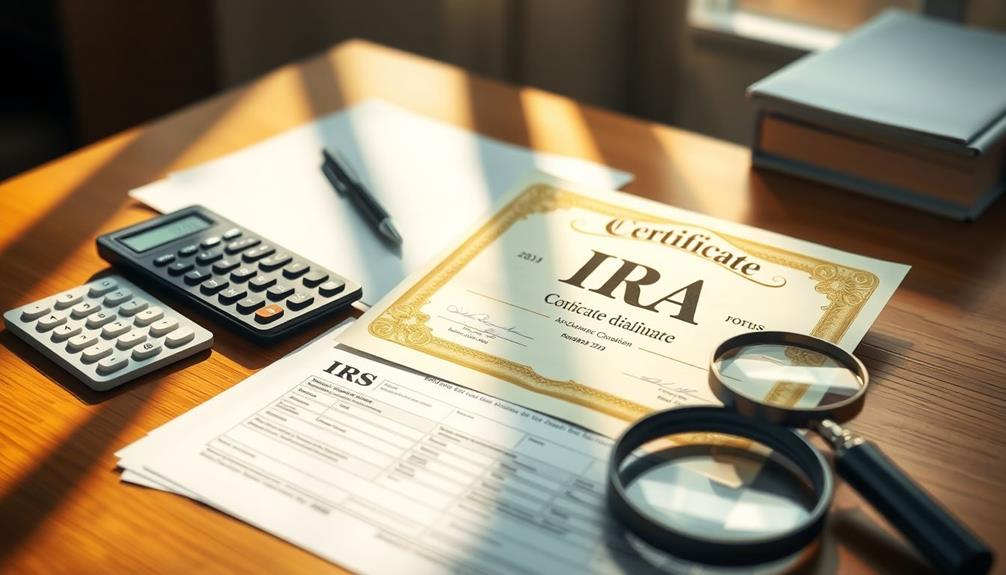Investing in a Gold IRA can help diversify your retirement portfolio and protect your savings from market downturns. This type of account allows you to own physical gold and other precious metals, potentially providing tax benefits. You must adhere to IRS purity standards and store your gold in authorized depositories. There are different types of Gold IRAs available, such as traditional and Roth options, each with their own advantages. It’s important to be aware of contribution limits, fees, and rules to avoid penalties. By researching your choices, you can discover effective strategies for successful Gold IRA investing that may improve your financial outlook.
Key Takeaways
- A Gold IRA is a self-directed retirement account that allows investment in physical gold and precious metals, offering diversification and potential tax benefits.
- Types of Gold IRAs include Traditional, Roth, and Self-Directed, each with unique tax implications and contribution limits.
- Contribution limits for 2024 are $7,000 for individuals under 50 and $8,000 for those 50 and older, with strict IRS compliance required.
- Gold must meet a minimum purity standard of 99.5% and must be stored in IRS-approved depositories to ensure compliance.
- Benefits include protection against inflation, wealth preservation, and stability during economic uncertainties, making Gold IRAs an attractive investment option.
What Is a Gold IRA?

A Gold IRA is a unique type of self-directed individual retirement account that lets you invest in physical gold and other precious metals like silver, platinum, and palladium. This specialized account allows you to diversify your retirement portfolio by including tangible assets that historically hold their value against inflation and market volatility.
Investing in a Gold IRA can also provide potential tax advantages and protection against market downturns, making it an appealing option for many investors looking to explore IRA rollover options. Additionally, the benefits of gold IRAs include diversification of your retirement portfolio, which can help reduce overall risk. By holding physical gold or other precious metals, investors can hedge against inflation and currency fluctuations, ensuring greater financial stability. For those considering long-term strategies, gold IRAs offer a unique opportunity to preserve wealth while taking advantage of potential growth in the value of precious metals.
Unlike traditional IRAs, you can't store your physical gold at home. Instead, the IRS mandates that you keep these assets in IRS-approved depositories. This guarantees that your investments are secure and compliant with federal regulations.
Additionally, a Gold IRA must adhere to strict IRS guidelines, including purity standards for metals—gold must be at least 99.5% pure.
When investing in a Gold IRA, you'll find various options, such as Traditional, Roth, self-directed, and SEP IRAs, each with its own tax implications and contribution limits. As of 2024, you can contribute up to $7,000 annually if you're under 50.
It's crucial to work with a custodian who manages your account, guaranteeing compliance and handling the purchase and storage of your precious metals effectively.
Benefits of Gold IRAs

Numerous benefits come with investing in a Gold IRA, making it an attractive option for retirement savings. One of the most significant advantages is that gold acts as a hedge against inflation.
According to industry insights, many investors are drawn to Gold IRA options due to their potential for wealth preservation and stability. When inflation rises, gold often retains its value, providing stability during economic uncertainty.
Additionally, including gold in your retirement portfolio can help reduce overall volatility and risk, as it typically trends inversely to traditional assets like stocks and bonds.
Here are some key benefits of investing in a Gold IRA:
- Hedge against inflation: Protects your savings when traditional currencies decline in value.
- Wealth preservation: Historically appreciates over time, maintaining purchasing power.
- Tax advantages: Potential for tax-deferred growth and tax-free withdrawals in Roth Gold IRAs.
- Diversification: Allows you to diversify your retirement portfolio beyond conventional investments.
- Stability in downturns: Safeguards your wealth against economic uncertainties and market downturns.
Types of Gold IRAs

When you're considering a Gold IRA, you've got a few main types to choose from. The Traditional Gold IRA and Roth Gold IRA each offer unique tax advantages, making them suitable for different financial situations.
The benefits of Gold IRAs also include the potential for long-term capital appreciation and protection against economic downturns, while the Self-Directed Gold IRA gives you more control over your investments.
Understanding these options is key to making the best choice for your retirement strategy.
Traditional Gold IRA
Investing in a Traditional Gold IRA opens the door to a unique way of diversifying your retirement portfolio with tangible assets. This type of account allows you to invest in physical gold and other precious metals while enjoying tax-deferred growth until you make withdrawals in retirement.
Here are some key points to take into account:
- Contributions can be made with pretax dollars, potentially lowering your taxable income.
- The IRS mandates that gold must meet purity standards of at least 99.5%.
- Required Minimum Distributions (RMDs) kick in at age 72, requiring annual withdrawals.
- Withdrawals are subject to ordinary income tax, unlike other retirement accounts.
- Investing in a Traditional Gold IRA can help protect your retirement savings against inflation.
Understanding the rules and implications of a Traditional Gold IRA is essential for effective retirement planning.
By taking advantage of its tax benefits and tangible asset protection, you can secure a more stable financial future.
Just be sure to consult with a financial advisor to navigate the complexities associated with these types of accounts and guarantee compliance with IRS regulations.
Roth Gold IRA
A Roth Gold IRA offers a compelling alternative for those looking to invest in physical gold and other precious metals while benefiting from tax-free growth and withdrawals in retirement. With contributions made using after-tax dollars, you can enjoy significant tax advantages when you reach retirement age.
Here's a quick comparison of key features:
| Feature | Roth Gold IRA | Traditional Gold IRA |
|---|---|---|
| Contribution Limits | $6,500 ($7,000 if 50+) | $6,500 ($7,000 if 50+) |
| Tax Treatment | Tax-free growth | Tax-deferred growth |
| Required Minimum Distributions | No | Yes |
| Investment Storage | IRS-approved depositories | IRS-approved depositories |
| Contribution Timing | After-tax | Before-tax |
To open a Roth Gold IRA, you'll need to select a qualified custodian who specializes in precious metals, as typical brokers don't handle these accounts. Remember, eligible investments must meet strict IRS standards, including a purity level of at least 99.5% for gold. This setup provides you with flexibility and the potential for greater growth over time.
Self-Directed Gold IRA
Offering greater control over your investment choices, a Self-Directed Gold IRA lets you diversify your portfolio with physical gold, silver, and other approved precious metals.
Unlike traditional IRAs, this self-directed IRA empowers you to make your own decisions about purchasing, storing, and managing your precious metal assets.
When considering a Self-Directed Gold IRA, keep these key points in mind:
- You can fund it through rollovers or direct contributions.
- The IRS contribution limits are $6,500 for individuals under 50 and $7,000 for those over 50 in 2024.
- Verify your custodian is IRS-approved to comply with IRS regulations.
- Precious metals must meet specific purity standards (e.g., gold must be at least 99.5% pure).
- Physical gold must be stored in approved depositories; home storage isn't permitted.
Eligibility and Requirements

To qualify for a Gold IRA, you need to meet specific eligibility criteria. Gold IRAs require that you have earned income or the ability to roll over funds from an existing retirement account, like a 401(k) or traditional IRA.
It's essential to understand the eligibility and requirements set by the IRS to guarantee compliance and maximize your investment.
As of 2024, contribution limits are $7,000 annually for individuals under 50 and $8,000 for those aged 50 and older. Additionally, the precious metals you choose must adhere to strict purity standards—gold must be at least 99.5% pure.
All Gold IRAs must be managed by an IRS-approved custodian who specializes in precious metals. This guarantees that your investment aligns with IRS guidelines and that your assets are stored securely.
Keep in mind that once you reach age 72, required minimum distributions (RMDs) apply. This means you'll need to either liquidate or ship gold assets to meet these requirements.
Understanding these factors will help you navigate the process and make informed decisions regarding your Gold IRA.
Setting Up a Gold IRA

To set up a Gold IRA, you need to choose a reputable custodian who specializes in precious metals since traditional brokers can't handle these accounts.
You'll also want to understand the contribution limits, as they can affect how much you can invest each year.
Choosing a Custodian
Choosing the right custodian for your Gold IRA is vital for a successful investment experience.
You'll want to confirm that the custodian you choose is IRS-approved and has a solid reputation in the industry. This will help you manage your investment effectively and remain compliant with regulations.
Here are some factors to take into account:
- IRS-Approved: Verify that the custodian is recognized by the IRS to handle Gold IRAs.
- Fees: Compare custodial fees, including setup, annual maintenance, and storage costs, as these can greatly affect your returns.
- Secure Storage: Look for custodians offering secure storage options in IRS-approved facilities, which is important for maintaining your tax-advantaged status.
- Customer Service: Evaluate the custodian's customer service; a knowledgeable team can guide you through account management and compliance.
- Experience: Research the custodian's experience with precious metals, as those with a strong track record can provide valuable insights.
Understanding Contribution Limits
Understanding contribution limits is vital when setting up a Gold IRA. For 2024, you can contribute a maximum of $7,000, with an additional $1,000 catch-up contribution if you're 50 or older. These limits remain unchanged from the previous year and are set by IRS guidelines.
Remember, contributions can only come from earned income or rollovers from existing retirement accounts.
Both Traditional and Roth Gold IRAs follow the same contribution limits, but it's significant to recognize that these limits can change annually based on inflation and IRS regulations. Staying informed about potential adjustments is essential for effective retirement planning.
Be cautious with your contributions, as exceeding the limits may lead to penalties that can impact your investment returns. Monitoring your contributions closely will help guarantee compliance with IRS rules and keep your Gold IRA in good standing.
Storage and Security Options

When it comes to storing your precious metals in a Gold IRA, security is paramount. You can't store physical gold at home due to IRS regulations; it must be kept in an IRS-approved depository. Choosing the right storage option not only protects your investment but also provides peace of mind.
Here are some key aspects to take into account:
- Professional vault storage: Offers enhanced security and protection against theft.
- Insurance: Insuring your precious metals is vital to safeguard against loss or damage.
- 24/7 security: Many custodial facilities provide round-the-clock monitoring to enhance safety.
- Climate control: Proper storage conditions help maintain the integrity of your metals.
- Storage fees: Be aware of the fees associated with storing your gold, as they can vary by facility.
Regularly check your storage conditions and maintain appropriate documentation to guarantee compliance with IRS guidelines.
IRS Rules and Compliance

When you set up a Gold IRA, you must follow specific IRS compliance requirements to keep your account in good standing.
This includes reporting your contributions and distributions accurately, as failure to do so can result in penalties or loss of tax advantages.
Understanding these rules is essential for managing your investment effectively.
IRS Compliance Requirements
Steering through the IRS compliance requirements for Gold IRAs is essential for maintaining the tax-advantaged status of your investment.
Understanding and adhering to IRS rules will help you avoid costly penalties and keep your retirement funds intact. Here are some key compliance points to evaluate:
- The gold must be at least 99.5% pure to qualify for tax advantages.
- All gold and precious metals must be stored in an IRS-approved depository; home storage isn't allowed.
- Required Minimum Distributions (RMDs) kick in at age 72, and you can choose to take gold shipments or liquidate.
- Contributions have annual limits: $7,000 for those under 50 and $8,000 for those 50 and older as of 2024.
- Non-compliance, like buying ineligible metals or improper storage, can lead to penalties and loss of tax benefits.
Reporting Contributions and Distributions
Understanding how to report contributions and distributions from your Gold IRA is essential for avoiding potential penalties and ensuring compliance with IRS regulations.
For 2023, you can contribute up to $6,500, or $7,000 if you're 50 or older, plus a catch-up contribution of $1,000. Keeping your contributions within these limits is vital for proper reporting.
When it comes to distributions, be aware that starting at age 72, you're required to take minimum distributions (RMDs) each year. Failing to withdraw the mandated amount can lead to significant penalties.
Accurate reporting of both contributions and distributions is critical, as noncompliance with IRS regulations can result in unwanted tax implications.
Your Gold IRA custodian plays a key role in this process by providing you with Form 5498 for reporting contributions and Form 1099-R for distributions.
Make sure to maintain detailed records of all your contributions and withdrawals to facilitate accurate reporting on your tax returns.
Costs and Fees Involved

Managing the costs and fees involved in setting up a Gold IRA is essential for making informed investment decisions. When considering a Gold IRA, you'll encounter various fees that can impact your overall investment.
Here's a breakdown of what to expect:
- One-time setup fees: Ranging from $50 to $300, depending on the custodian and services.
- Annual custodial fees: These typically range from $100 to $300 for account management and IRS compliance.
- Storage fees: Expect to pay between $100 and $500 annually for holding your physical gold in approved depositories.
- Transaction fees: When buying or selling gold, fees usually range from 1% to 5% of the transaction amount.
- Additional insurance costs: Protecting your physical gold may involve extra expenses that you should factor in.
Understanding these costs and fees guarantees you're aware of the true investment required for a Gold IRA.
Risks of Gold IRA Investing

While you may find the potential benefits of a Gold IRA appealing, it's important to be aware of the risks involved in this type of investment. One significant risk is the volatility of gold prices. Historical trends show that gold can experience dramatic fluctuations, like the nearly 28% drop in 2013 from the previous year's high. Such volatility can impact your investment's value substantially.
Additionally, investing in a Gold IRA comes with ongoing costs, including storage and insurance for your physical gold. These expenses can add up to several hundred dollars annually, eating into your returns.
Regulatory compliance is another critical aspect; failing to adhere to IRS rules regarding storage and purity can lead to penalties or even disqualification of your IRA's tax advantages.
Moreover, liquidity can pose challenges. Selling physical gold often takes longer and is more complex than liquidating stocks or bonds.
Strategies for Gold Investment

To maximize your Gold IRA investment, it's crucial to adopt effective strategies that align with your financial goals. Here are key approaches to enhance your Gold IRA investing experience:
- Focus on Long-Term Growth: Embrace a long-term investment perspective since gold tends to appreciate over time, especially during economic downturns.
- Make Regular Contributions: Consistent contributions help build wealth and leverage dollar-cost averaging, mitigating market fluctuations.
- Engage in Portfolio Rebalancing: Regularly assess your allocation between gold and other assets to maintain desired risk levels and adapt to changing market conditions.
- Implement Market Monitoring: Stay informed about market trends, economic indicators, and geopolitical events that could impact gold prices. This helps you make timely investment decisions.
- Prioritize Diversification: Incorporating gold into your portfolio can mitigate risks linked to stock market volatility and inflation, providing a stable asset class that often trends inversely to the U.S. dollar.
Frequently Asked Questions
What Is the Downside of a Gold Ira?
A gold IRA's downsides include strict regulations, extra fees for custodial services, and lack of income generation. You might also face complex liquidation processes and price volatility, which can affect your investment's overall performance and liquidity.
How Much Money Do You Need to Start a Gold Ira?
To start a Gold IRA, you'll generally need between $5,000 and $25,000, depending on the custodian. Remember, you can contribute up to $7,000 annually, or $8,000 if you're over 50.
How to Get Started With a Gold Ira?
To get started with a Gold IRA, choose a reputable custodian, fund your account through rollovers or contributions, select IRS-approved precious metals, and guarantee your gold is stored in an IRS-approved depository.
How Do I Get Out of a Gold Ira?
When it's time to leave your Gold IRA, think of it as a treasure hunt. You can either sell your gold for cash or roll it into another account. Just follow IRS rules to keep your benefits.
Conclusion
To sum up, a Gold IRA can be a smart way to diversify your retirement portfolio and protect your wealth from economic uncertainty. By understanding the benefits, types, and requirements, you can make an informed decision that aligns with your financial goals. Isn't it time you considered how a Gold IRA could strengthen your investment strategy? With careful planning and research, you can navigate the complexities and enjoy the potential rewards of gold investing.









